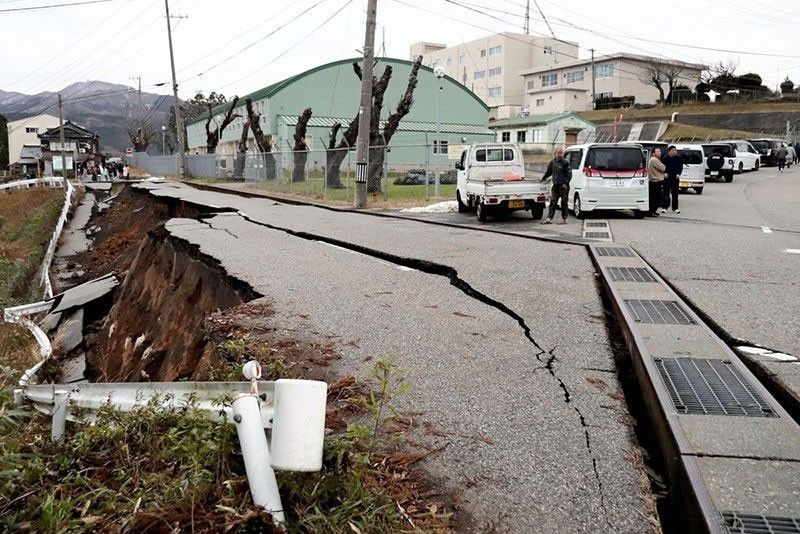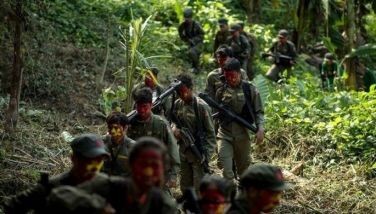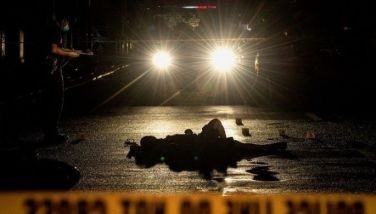New Year’s Day quakes in Japan leave 48 dead

WAJIMA – Japanese rescuers battled the clock and powerful aftershocks yesterday to find survivors of a New Year’s Day earthquake that has killed at least 48 people and caused widespread destruction.
The magnitude 7.5 quake that rattled Ishikawa prefecture on the main island of Honshu triggered tsunami waves more than a meter high, toppled houses, caused a major fire and tore apart roads.
On the Noto Peninsula, the destruction included buildings damaged by fire, houses flattened, fishing boats sunk or washed ashore and highways hit by landslides.
“I’m amazed the house is this broken and everyone in my family managed to come out of it unscathed,” said Akiko, standing outside her parents’ tilting home in the badly hit city of Wajima.
The way 2024 started “will be etched into my memory forever,” she told AFP after what she called the “long and violent” earthquake last Monday.
“It was such a powerful jolt,” Tsugumasa Mihara, 73, told AFP as he queued with hundreds of others for water in the nearby shell-shocked town of Shika.
Local authorities put the death toll at 48, but the number was expected to rise as rescuers comb through the rubble.
“Very extensive damage has been confirmed, including numerous casualties, building collapses and fires,” Prime Minister Fumio Kishida said after a disaster response meeting.
“We have to race against time to search for and rescue victims of the disaster,” Kishida added.
Aerial news footage showed the terrifying scale of a fire that ripped through the old market area of Wajima, where a seven-story commercial building also collapsed. Quake damage impaired rescue efforts to put out the blaze.
Almost 33,000 households were without power in the region, which saw temperatures touch freezing overnight, according to the local energy provider.
Many cities were without running water.
The United States Geological Survey said the quake had a magnitude of 7.5. Japan’s meteorological agency measured it at 7.6 and said it was one of more than 150 to shake the region through yesterday morning.
Several strong jolts were felt early yesterday, including one measuring 5.6 that prompted national broadcaster NHK to switch to a special program.
“Please take deep breaths,” the presenter said, reminding viewers to check for fires in their kitchens.
Tsunami warning lifted
Last Monday, waves at least four feet high hit Wajima and a series of smaller tsunamis were reported elsewhere.
Warnings of much larger waves proved unfounded and Japan yesterday lifted all tsunami warnings.
Images on social media showed cars, houses and bridges in Ishikawa wobbling violently as terrified people cowered in shops and train stations.
Houses collapsed and huge cracks appeared on roads while others were hit by landslides.
Forecasters warned that rains could further loosen soil on hillsides.
A team of firefighters crawled under a collapsed commercial building in Wajima looking for survivors, television footage showed.
“Hang in there! Hang in there!” they shouted as they battled through piles of wooden beams with an electric saw.
The fire in Wajima engulfed as many as 200 structures, according to reports, with people evacuated in the dark, some with blankets and others carrying babies.
NHK reported that 25 houses had collapsed in the city, including 14 that may have had people trapped inside.
A duty officer at the Wajima Fire Department said that authorities were overwhelmed yesterday by rescue calls and reports of damage.
Ishikawa Gov. Hiroshi Hase wrote on social media that roads had been cut in widespread areas by landslides or cracking, while at the port of Suzu, “multiple” vessels had capsized.
A total of 62,000 people had been ordered to evacuate, according to the fire and disaster management agency.
About 1,000 were staying at a military base, the defense ministry said.
Bullet trains suspended
Monday’s quake shook apartments in the capital Tokyo about 300 kilometers away, where a public New Year’s Day greeting event by Emperor Naruhito was canceled.
Overnight about 1,400 people were stuck on suspended bullet trains, including Georgia’s Ambassador Teimuraz Lezhava, who praised the “kindness of the station staff and the passengers around us” on social media.
Around 1,000 others were stuck in local express trains for almost 24 hours after they were halted last Monday, according to NHK.
About 500 people were also stranded at Noto’s damaged airport, with access roads blocked and the runway riddled with cracks.
Japan experiences hundreds of earthquakes every year and the vast majority cause no damage.
The number of earthquakes in the Noto Peninsula region has been steadily increasing since 2018, a Japanese government report said last year.
The country is haunted by a massive magnitude 9.0 undersea quake off northeastern Japan in March 2011, which triggered a tsunami that left around 18,500 people dead or missing.
It also swamped the Fukushima atomic plant, causing one of the world’s worst nuclear disasters.
Japan’s nuclear authority said that there were no abnormalities reported at the Shika atomic power plant in Ishikawa or other plants after the latest quake.
China yesterday joined the US and other countries in expressing condolences.
No Pinoys hurt
No Filipino was reported injured in the magnitude 7.6 earthquake that struck central Japan on New Year’s Day, the Department of Foreign Affairs (DFA) said yesterday.
DFA Undersecretary Eduardo Jose de Vega said the Philippine consulate general in Nagoya is monitoring the situation of Filipinos in affected areas.
“The Filipino community has been contacted and no reports of any Filipino casualty at this time,” De Vega said in a text message.
“Following established emergency procedures, local communities are following prefectural government announcements to keep safe in higher ground for the moment. Avoid bridges and roads as some have sustained damage,” he added.
Ambassador to Japan Mylene Albano said the Philippine embassy has not received reports of Filipinos injured in the earthquake that struck near the Noto Peninsula in Ishikawa prefecture last Monday, triggering the country’s first major tsunami warning since the March 2011 earthquake and tsunami.
The tsunami warning prompted residents to flee to higher ground as tsunami waves hit Japan’s west coast.
“We have not received reports of Filipinos injured here due to the earthquake. The information that we are getting from our Filipino communities in the affected areas is that some have gone to evacuation centers. There were those who have gone to the city hall because they were asked to evacuate to avoid the possible tsunami,” Albano said in Filipino and English in a TeleRadyo Serbisyo interview.
One hundred fifty-seven Filipinos have been evacuated due to the tsunami warnings.
The consulate has posted necessary advisories to the Filipino community and is monitoring developments.
At least 1,300 Filipinos reside in Ishikawa Prefecture, the epicenter of the earthquake, according to the DFA. It falls under the coverage of the Philippine consulate general in Nagoya.
Philippines ready to aid Japan
The Philippines is ready to send assistance to Japan following the New Year’s Day earthquake, President Marcos said yesterday as he also gave assurance on the safety of Filipinos there.
“We are deeply saddened to hear of the magnitude 7.6 earthquake in Japan on New Year’s Day,” Marcos said in a post on his official X (formerly Twitter) account.
“We have made the offer to assist in any way that we can. In the face of shared climate challenges within the Pacific Ring of Fire, we stand united with Japan and stay ready to provide support from the Philippines,” he added.
The Philippine government is in close collaboration with the Japanese government to secure the welfare of Filipinos who, “thankfully, remain unharmed,” according to the President.
The Department of Migrant Workers (DMW) is likewise closely monitoring the situation of overseas Filipino workers (OFWs) in Japan, particularly in Ishikawa and Toyama Prefectures, according to the Presidential Communications Office (PCO).
DMW officer-in-charge Undersecretary Hans Leo Cacdac said there are a total of 1,194 Filipinos living in the two prefectures – 469 in Ishikawa and 725 in Toyama.
Around 90 percent of Filipino workers there are in the manufacturing, welding and carpentry sectors, while a smaller percentage of around 10 percent are caregivers, according to Cacdac.
“We will provide financial assistance to OFWs whose employment have been suspended or ceased due to the quake,” Cacdac was quoted by the PCO as saying.
“A report on the condition of workers or any incident involving Filipino workers due to the natural calamity must be submitted through the DMW office,” the DMW said in an advisory issued after the earthquake.
The agency requested supervising organizations and principals to monitor the safety of their Filipino workers and take precautionary measures as the situation develops.
It has already activated a helpline for OFWs and their families affected by the earthquake.
OFWs and their family members seeking assistance or information may call the DMW-OWWA Japan Helpdesk at hotline 1348 or +632-1348 (from abroad).
Affected OFWs may also call the DMW-MWO-Osaka Hotline numbers at +817022756082 or +817024474016.
Last Monday night, the Overseas Workers Welfare Administration (OWWA) said it had not received any report of casualty as a result of the quake.
OWWA administrator Arnell Ignacio said about 1,087 Filipinos are staying in the quake-affected area.
Ignacio said the Philippine government is closely watching developments in Japan and exerting efforts to ensure the safety of the OFWs there.
The Philippines and Japan are both geographically prone to disasters, owing to their location in the Pacific Ring of Fire, where the majority of the world’s strongest earthquakes occur.
AFP, OCD ready
The Armed Forces of the Philippines (AFP) expressed its readiness yesterday to help the Japan Self-Defense Force (JSDF) in any way possible following the latest calamity that shook Japan on Monday.
“In times of crisis, international cooperation becomes paramount, and the AFP expresses its readiness to collaborate with the JSDF in any way deemed necessary,” AFP chief Gen. Romeo Brawner Jr. said in a statement.
Brawner declared that the AFP stands in solidarity with the JSDF following the strong earthquake that struck Japan’s western coastline.
“Recognizing the severity of the situation and the subsequent issuance of major tsunami warnings, the AFP extends its support and sympathy to the Japanese people,” he said.
The Office of Civil Defense (OCD) also expressed its readiness to help in response operations in Japan as announced by Marcos himself.
The OCD gave assurance that it is on standby and “will continue to monitor the situation and make necessary arrangements for the possible support that we can extend.”
Meanwhile, Philippine Airlines spokesperson Cielo Villaluna said that based on updates from the PAL Tokyo station, the New Year’s Day quake did not affect its flights to and from Tokyo.
“No reported damage on the airport in Narita. Our flight operations remained normal,” Villaluna added. – Michael Punongbayan, Mayen Jaymalin, Rudy Santos
- Latest
- Trending





























